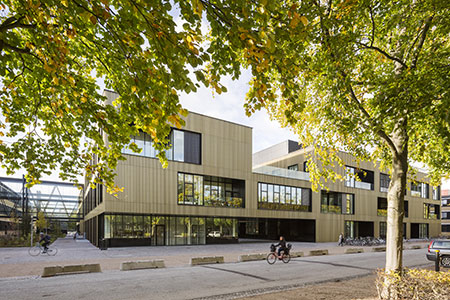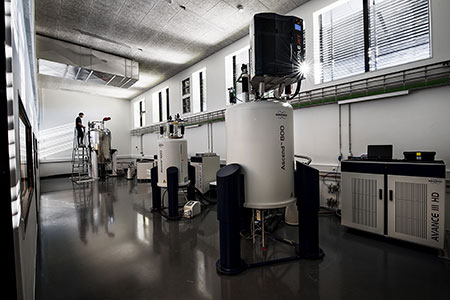Since 2010, DTU has accelerated new building projects—as well as development and renovation of the existing buildings at DTU—to make room for new, ultra-modern, research facilities. Several projects are upgrading the research infrastructure in DTU’s life science activities.
 |
BUILDINGS 301, 306, 307, 309
Quantum technology for medical purposes.
The buildings are to be refurbished and modernized. The building houses research into—among other fields—quantum technology, which can be used for medical purposes, where quantum mechanical diamond sensors measure brain signals or detect cancer cells.
|
BUILDING 344
Optimized laboratory building
An increasing number of projects in biomedicine as well as two basic research centres—including in drug delivery through nanocapsules and microcapsules—result in an increased need for more modern laboratories.
|
|
 |
 |
|
BUILDINGS 201-205
More than 250 specialized laboratories
With more than 42,000 m2 of newly constructed and refurbished premises, the research environments in the food and veterinary field—as well as the aquatic resources—now have modern research facilities. The buildings house more than 250 specialized laboratories and teaching facilities. The research covers a wide range of fields, including sustainable exploitation of marine resources and ecosystems, food and health, food safety, antimicrobial resistance, immunology, development of vaccines, and lifestyle diseases.
|
BUILDING 211
Optimized chemistry laboratories
Physical, organic, and inorganic chemistry is now gathered under one roof in—among other facilities—newly built chemistry laboratories of 3,200 m2.
The laboratory design is well integrated and operationally optimized with room for 110 fume cupboards in four large teaching laboratories and eight research laboratories.
|
|
 |
 |
|
BUILDING 212
Advanced molecular research
A new NMR centre has moved into a building of 250 m2.
NMR stands for Nuclear Magnetic Resonance and can be used for analysis in chemistry and biology, including for identification of the toxic substances of mould fungus, or to search for pharmaceuticals to fight antibiotic-resistant bacteria.
|
BUILDING 220
Biotechnological high-rise
DTU’s tallest building of five floors is designed for biotechnological research into cells and development of robust cell factories which can efficiently produce valuable chemicals, food ingredients, fuel, and medicines. The building houses a total of 12,300 m2 containing several highly sophisticated research laboratories. |
|
 |
 |
|
BUILDING 225
New laboratory building for bioengineers
1,800 m2 new, modern laboratories for research and teaching in biotechnology, food technology, and biomedicine. The researchers’ mission is to create greater understanding of key biological correlations in diseases and health. |
BUILDING 228A
Test facilities for process and production research
DTU is expanding and improving its facilities for research into product design, process design, and production across chemistry, biotechnology, foods, pharmaceuticals, and energy with a new building of 5,600 m2, which will house test facilities, laboratories, classrooms, and workshop areas—among other facilities. |
|
 |
 |
|
BUILDING 324
Digital biology and health technology
Research activities in the new building of 4,600 m2 include digital biology—i.e. analysis and understanding of biological processes—as well as research into digital health technology, which comprises the development of medical devices and equipment, analysis of data on biosignals, cognitive processes, behaviour, and social networks.
The researchers are also engaged in work with virtual reality, big data, as well as brain research, and the latest brain scanning techniques.
|
BUILDING 340
Research into optics and light
New laboratories with sophisticated equipment for light research are located at basement level and in the interior of the new building of 3,800 m2 to ensure darkness and avoid vibrations from the surroundings.
The light researchers’ life science research covers biomedical applications of optics and laser technology, as well as optical signal processing, imaging, and telemedicine.
|
|
 |
 |
|
BUILDING 345C
More space for nanotechnology
A new building of 1,500 m2 creates more space while also connecting the nanoresearchers with DTU’s clean room at Danchip, which is a hi-tech production facility in microtechnology and nanotechnology.
Nanotechnology at DTU includes drug delivery, pharmaceutical development, immunotherapy, nanomedicine, lab-on-a-chip, and implants.
|
BUILDING 354
Highly specialized facilities for hearing research
DTU’s hearing research has been upgraded with the world’s most sophisticated laboratory facilities. This includes a new anechoic chamber, which can be used to study the interaction between spatial hearing and audiovisual stimuli. In the physiology lab, researchers can study where and how the brain processes acoustic and audiovisual information.
|
|
 |
A new building is to be constructed with laboratories for research into environmental and resource problems.
The work conducted by the researchers includes the development of technologies which support recycling and utilization of residual products such as waste, farmyard manure, building waste, and wastewater.